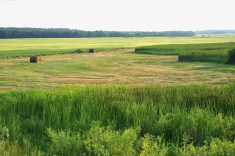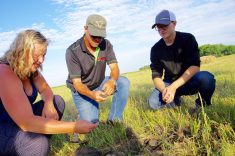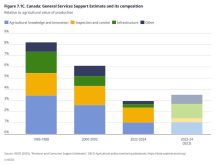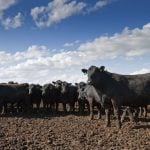New research is exploring another crucial ecosystem function to agriculture — the role shelterbelts play in maintaining soil fertility by sustaining soil biological activity
Scientists and environmental agencies inform us that agriculture on the prairie, like in most parts of the world, is becoming more vulnerable as climate changes, energy cost rises and natural resources including organic matter and biodiversity are depleted.
This increased vulnerability not only threatens food security at a global scale (the Canadian Prairies contributes to 20 per cent of international wheat trade), but also the mere survival of Prairie communities. Besides reducing contribution to climate change and natural resources depletion, sustainable development experts urge rural communities to heighten agro-systems robustness and adaptability to climate changes “undesirable effects” (intensified weather variability, increased drought frequency, lower water storage capacity, and changes in precipitation patterns).
Read Also

Manitoba to boost rural medical responders
Manitoba bursary aims for more accessible emergency medical responder training, better rural emergency health care.
Long-term research in sustainable agriculture proves that trees in the agro-landscape help agriculture productivity and increase resilience to climate change. Judiciously chosen species of trees can contribute to farm total production (fruit, timber, energy, medicine) while fulfilling ecosystem services for crop production (windbreak, nutrient cycling, microclimate, moisture, and habitat for beneficial insects).
New research is exploring another crucial ecosystem function to agriculture — the role shelterbelts play in maintaining soil fertility by sustaining soil biological activity.
Despite these staggering benefits, many farmers decide to eradicate trees from their operation. Today, more shelterbelts are being removed than planted, and combined with aging trees, one can question the future of agro-landscapes.
Many reasons drive farmers to give up on shelterbelts, the main reason being that the short-term cost-benefit ratio is not always in favour of trees. Farmers’ values and perception of trees reflect a change in farming practices, structure and local knowledge. Shelterbelts are often seen as part of traditional agriculture, but can very well be designed for and adapted to modern agriculture.
Shelterbelts not only provide economic benefits for agriculture production, but also provide services to the ecosystem and therefore to the rural society. Too often the community and politics underappreciate the importance of ecosystem functions and processes in society’s social and economic well-being. Conserving fertile soil, protecting water quality, enhancing air movement and biological connectivity in the landscape, reducing energy bills while capturing carbon, but also recreation opportunities, esthetic, bird-watching and the solely cultural identity of a community are few examples of shelterbelts’ multi-functionality. One might call it the backbone of Prairie rural communities’ resilience and sustainability.
Shelterbelt adoption and management faces several issues. Besides the lack of knowledge in shelterbelts possible designs, functions and benefits, there is most of all a problem of valuation between private and public costs benefits. If shelterbelts do not provide sufficient financial benefits to offset farmers’ implementation and maintenance costs, are the social and ecological benefits to society significant enough to justify an intervention from the public authority to remunerate or compensate farmers for the stewardship of these public benefits?
Conflicts between utilitarian versus non-utilitarian views, as well as production, conservation, recreation and cultural goals are expected. Nevertheless these conflicting values and goals ought to be explored in order to develop a shared vision that responds to the population wishes and needs while ensuring its sustainability. This should not be based on short-term economic return but long-term community health.
A survey is presently underway in the Rural Municipality of Stanley to determine farming and non-farming local knowledge, perceived benefits and willingness to pay for shelterbelts. We are hopeful this survey will help local farmers, natural resources managers and rural planners make informed decisions about shelterbelt management in the face of climate change.














